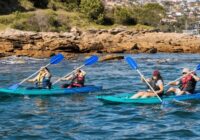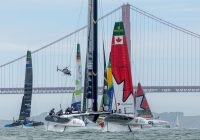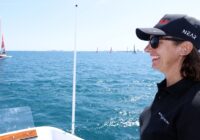Words by Alex Stone, Photography & video by Roger Mills, Boating New Zealand Magazine
The future of Hauraki Gulf boating – and indeed all of New Zealand’s coastal waters, rivers and lakes – is here. And it’s elegant as. The experience of being onboard Earthling the extraordinary E-cat left me speechless initially. And that’s very unusual for me.
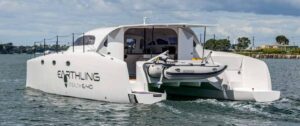
The thing about revolutionary ideas and technology, is that their adoption is never that hard. Because, almost always, their constituent components already exist. They just have to be recognised, and assembled intelligently. Earthling is just such an ‘integration house’, continually searching, striving for simplicity and efficiency which feeds the ethos of sustainability.
The E-40 PowerCat is the latest in a long line of engineering and boating innovations by John McGettigan, Earthling’s creator and owner. New Zealand boaties might well remember John’s previous iconoclastic boat, the so-powerful-it-was almost-unearthly sailing catamaran Earthling with its towering rig, automated leach control and distinctive silver-gold livery.
Before that John forged an international career in designing complex, automated industrial systems. And while living in South Africa, raced production motorcycles on the circuit. He’s always known how to get there, how to achieve seemingly impossible goals. And fast.
Now it would appear he’s found a new chapter. And slowed down a bit. But that’s something of an illusion, for he and Earthling the E-cat are full of the unexpected – as we shall see.
But going back a bit to introducing new technology, it’s littleknown that electric marine propulsion pre-dated diesel motors by 10 years, and over 100 years ago (see box).
The appeal of a motor with only one moving part is undeniable. Especially for an engineer like John, who in a previous life had his fill of working with those pesky, parts-rich, complicated internal combustion engines. Noisy too.
And now John has gone beyond all that and swapped that particular soundscape for the two German Molabo electric motors that power Earthling soundlessly, fed by a huge coachroof-mounted solar array supporting a 45kWh Lithium batteries system, supplemented by two 8.5kW Whisperpower DC Charge Genverters. All system components are dual redundant and represent leading edge European technology.

Travelling aboard Earthling is a bit like “sailing without sails”.
In the early days of the current revolution in New Zealand towards electric cars, a big part of the deal for new owners was ‘range anxiety.’ This finds its way to electric boats too. Indeed, despite electric boats being there first, by the early 1900s cars and boats would go much faster and farther with a tankfulof liquid fuel than with batteries. And it’s been that way ever since. Until now.
So John has made the choice to go hybrid. The generators, which use only 2.5 litres of diesel per hour, propel Earthling at ten knots. As part of future-proofing the boat, John says they can be converted to using biofuels – but with some loss of efficiency.
The extraordinary efficiency of Earthling as a cruising launch is due to her fine hulls based on the Stealth 36 powercat, designed by Aussie Alan Carwardine and built in Phuket, Thailand. To help things along, John sent the Thai builders highly-detailed 3D digital modelling for various customised aspects of the E-40. Built with core composite foam and carbon fibre inserts, the extended 12m cat weighs only 3.6 tonnes. John had intended fitting the systems in Phuket before shipping the boat to Europe, however covid intervened and the empty hull was instead shipped to Auckland for the fit-out.
Which brings us back to the range anxiety thing. Having crunched all the numbers, John concluded that adding more batteries – and consequently much more weight – would only result in a self-defeating cycle of being heavier and not going any further. Says John, “The boat is optimised at this weight – it’s so easy to push.” So Earthling, with a full battery charge, has a range of up to 40 nautical miles on storage alone at slower speeds; around 20nm at 8 knots and 18nm at 10 knots, the sweet spot. As with any power boat, high speeds take a lot of energy, so the design concept of ‘Sailing without Sails’ allows easy passage-making at comfortable speeds and short, high-speed hops if required.
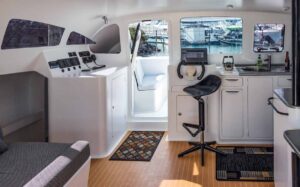
The interior fitout is focussed around keeping weight down, but still manages to be comfortable, functional and smart looking.
Although lightweight, Earthling can accommodate a payload of another tonne. And at a Christmas party, Earthling had 14 adults aboard. No worries.
On a weekend trip to Kawau just before we went out on Earthling for these photos, John says the diesels kicked in for the last 5nm of the 32nm trip there, this at 80% DOD. The design retains energy for 230VAC house loads overnight. The backup Genverters automatically start enroute to retain 20% capacity; house loads can be high for short timeframes, but kWh draw is minimal compared to E-Propulsion. As an example, while cooking a roast the combi oven may run for 30mins @ 1.8kW, so uses only 1kW of the 45kWh stored. No generator running required at anchor for a true silent ship.
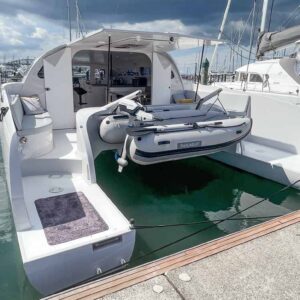
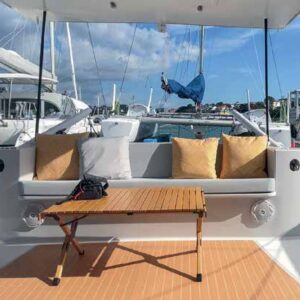
At anchor under sunny skies it would take around three days to fully recharge the batteries from the solar panels. A free top-up. You can’t say that of any ICE. From shore power, Earthling’s batteries can be recharged in about two hours.
So the hybrid system is an intelligent compromise for this boat. As John says, “Island-hopping by electric alone; passagemaking must be hybrid.”
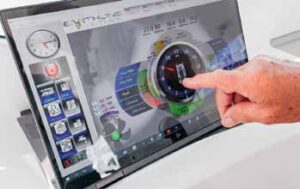
Cutaway shows the vessel’s hybrid propulsion system, everything monitored and controlled via E-Thos on a tablet at the helm, or remotely.
The two Molabo electric motors, impressive products from a German start-up company, can provide up to 50kW of energy continuously, though John has limited the drives to 30kW. At Earthling’s cruising speed of 10 knots, the motors draw 15kW – 7.5kW each. If running on one engine, simply run at 15KW – part of a complete dual redundancy platform. With fully depleted storage the Genverters provide the 15kW (2 x 8.4kW) to continue the passage at 10 knots.
The extra power of the 50kW Molabos is a reassuring safety feature: during a 5am New Year’s Eve blow which suddenly turned Waiheke’s Oneroa Bay into a 30-knots lee shore, John and Earthling and co. had “a ton of power to get out of trouble.”
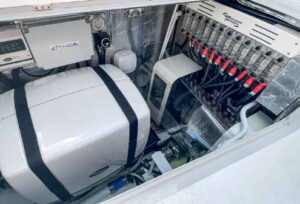
Whisperpower Genverters (in white sound-proofed boxes) kick in when needed. The electric motor can be seen at the head of the propshaft.
The secret to this power is large propellers – 600mm in diameter – turning at a surprisingly slow 400-600rpm. Optimised for the 10-knot sweet spot, they lose efficiency if turning any faster.
To get some good shots for Roger Mills’ drone photography, John cranked Earthling up to 18 knots boat speed. But, surprisingly for the speed merchant of old, John says, “I don’t like talking about speed with this Earthling. It’s inefficient, chews power and adds stress. However it is available if required.
“This boat is all about working with nature. We really must become more comfortable being self-sustaining. Energy efficiency is key to this outcome.”
The feeling of oneness with the environment is the main positive and overwhelming impression of being aboard Earthling. It’s just so quiet. There’s none of that thumping engine noise, none of that straining for the boat to break out of displacement mode, no lumpy wake thrown up.
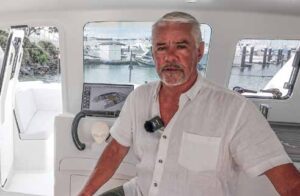
John McGettigan
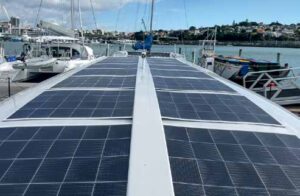
The flexible solar panel array is good for 2kW and can also be utilised to heat water.
This is “really sailing without sails,” John observes. With the sun pushing us, ultimately, rather than the wind. I agree. Doing 10 knots feels like nothing. Or like sitting on the couch at home. The fine hulls cut through the water with no rooster tails, no sense of pushing great weight, or using massive amounts of power to hold the plane. And of course, in electric mode, no burning of fossil fuels, no fumes, no noise at all. It’s all very meditative.
“It’s hard to see the speed, hard to feel the speed,” says John. It’s clear that Earthling is “shaped for efficiency.”
shaped for efficiency.” John exudes this new-found calm too. He’s definitely in cruising mode.
When the diesel generators kick in while the boat is underway, the sound is a very soft hum and there’s no vibration at all. It’s like a dishwasher in the kitchen downstairs while you’re relaxing in the lounge upstairs.
There are many (unexpected) domestic analogies with Earthling. Running off a 230V system, all galley appliances are just like you have in your home kitchen – including the fridge for perfectly cold beers. And the boat can run a dive compressor onboard.
But perhaps the most impressive element of Earthling is the totality of systems aboard the boat – and those that can be controlled remotely. John has developed a customised system called E-Thos that controls all aspects of the boat – monitoring, navigation, re-charging, you name it. Even all the “hotel stuff” in John’s phrase – the water levels, the fuel, the kitchen appliances, the big inverter. It’s all in data at your fingertips through a touch screen by the helming station. Or on your devices wherever you are.
John’s over-riding concept for the E-Thos system is “operation by exception.” Meaning, you don’t need to worry about the complexities of the boat, or continually have to peer under the bonnet. The touchscreen will let you know immediately with visually-targeted alarms if ever a need arises. Otherwise, says John, “you don’t have to stress about anything.”
He demonstrated how he can start up the generators remotely – if the system tells him via smartphone, that some re-charging is necessary. Without the boat underway, the Whisperpower generators are still quiet. Like the almost inaudible sound of a sewing machine, indoors at your neighbours, two doors away.
In a sense, John’s focus is on E-Thos (the system) rather than Earthling (the boat). “It’s the systems we’re trying to get online.” By that he means to commercialise them for their practical, real-world advantages. “We first want to have two more E40s online, before we apply the system to other OEMs.” To that end, there are two build slots scheduled in 2023 for other discerning boaties, pioneers (like John) in the exciting new path technology has made available.
The E-Thos elevator pitch is this: “We specialise in systems that minimise fuel use and maintenance. Air, water, noise pollution and port calls are dramatically reduced.”
And there’s a no-nonsense provisor. “We are focused on our proven solution as a One Stop Shop with Worldwide Support. We do not get involved with DIY orphans or speed projects.”
A quick tour of layout and accommodation. Earthling is notable for its single-level, flowthrough layout. A doorway just by the helm station leads to a for’ard cockpit. In good weather conditions (as on our photo outing in the upper Waitemata Harbour), this door stays open, providing a fine through-flow of fresh air. I don’t know much about these things, but I imagine this amounts to fine maritime feng-shui.
Visibility from the helm station is unparalleled. As is quick access to either the for’ard cockpit and foredeck, or the aft cockpit and boarding steps. A small inflatable dinghy sits snug and unobtrusively from elegantly simple davits. It has an electric outboard, natch, and will soon have an even better one, employing a clever horizontal push configuration that John’s developing.
The starboard hull of Earthling has a queensized double berth and ensuite loo and shower. Port hull has a wide forepeak berth. John admits to losing some possible interior accommodation volume, due to the front cockpit. But then shows how that space is way more often used during languid cruising days.
To make up overnight accommodation options, a settee in the saloon extends to form another queen-side double berth. The battery banks take up quite some space in the hulls, under the bunks.
The European solar array on the coachroof, made up of soft panels to save weight, have a secondary usage too. John has a system where water can flow over them to be heated for domestic use while also cooling the panels for better output.
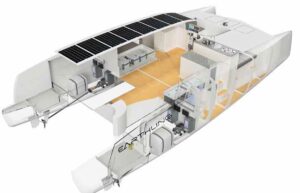
The overall impression of Earthling is of cleanness – of the lines, of the layout, of the whole strikingly distinctive boat. But most of all, a cleanness of thinking. John has melded the best of current technologies in Earthling. He has created an eminently practical fusion of pure electric and hybrid boat. One that is the future, now.
As we tied up back in the marina, Earthling continued to turn heads. Passers-by all wanted to stop and talk about the remarkable launch. John was happy to oblige.
“This boat is all about sustainability and resilience at sea,” says John. Too right, and all that achieved with a surfeit of elegance.
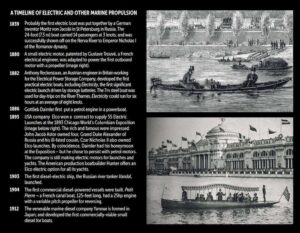
Base price: EUR 895,000
Price as reviewed: $POA
Design & build: Based on a design by Alan Cawardine. Built in Thailand www.earthlingethos.com
Specifications:
loa – 12m
beam – 5.5m
draft – 0.75m
displacement – 3,600kg
berths – 5 (two doubles, one single)
electric motors/model/power – 2 x Molabo ISCADV50
solar capacity – 2kW
battery type/capacity – Lithium44kWh (4 x WP PowerPro Towers)
cruising speed – 10 knots
max speed – 18 knots
For those wanting a closer look, the E40 demonstrator will be in Brisbane soon. Contact John at









